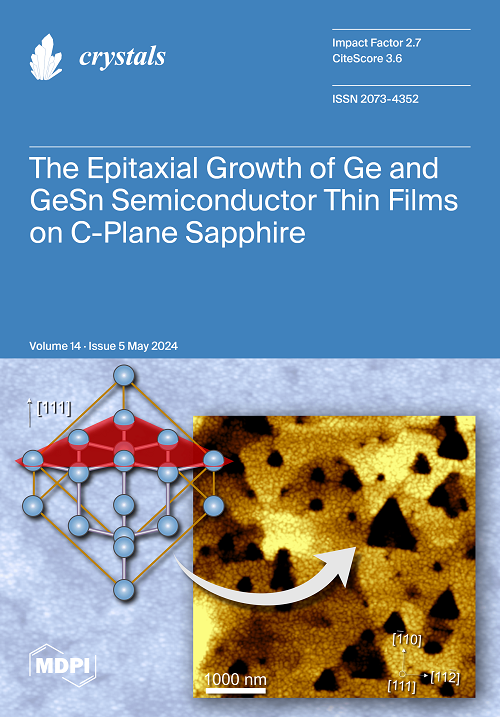A Bi-Pronged Attempt at Normalizing DL-EPRT Vis-à-Vis Grain-Boundary/σ-Phase Locales in Thermally Sensitized UNS S32205 Duplex Stainless Steel
IF 2.4
4区 材料科学
Q2 CRYSTALLOGRAPHY
引用次数: 0
Abstract
In a quest to vet UNS S32205 as a potential structural material to serve moderate-to-high temperature operations of NPP auxiliary components, the DL-EPR test was exploited. A bifronted scheme comprised of 650 and 850 °C discrete treatments intended to explore progressive eutectoid decomposition and degree-of-sensitization (DoS) scenarios was adopted. The nuance witnessed with yet another dual approach—the Cihal- and image processing (IP)-normalized signal landscape—was rationalized through its attribution to culprit microstructures. This was sought, inter alia, in the vicinity of grain boundaries and σ-phase inclusions by virtue of postmortem FESEM, STEM-EDX, HRTEM SAED and XRD ascertainment. Discernable reactivation-kinetics resurgence was believed to mark the onset of deleterious σ-phase dissolution. This only came into fruition with longer ageing times (8–17 h) at 650 °C and succumbed to prematurely (1 h), and at DC biases more cathodic than −0.25 VAg/AgCl with the 850 °C counterpart. Opportune corroboration was offered in ir/ia breakaway for the respective conditions, which was unveiled to be particularly pre-emptive (5 h) with IP- vs. Cihal-normalized peers (8 h) related to the 650 °C condition. Meanwhile, the 850 °C condition endured a similar surge after as little as 1 h of ageing across the board, which hints at concomitant sigma-phase culpability.热敏化 UNS S32205 双相不锈钢中 DL-EPRT 与晶界/σ 相位置关系正火的双管齐下尝试
为了将 UNS S32205 作为一种潜在的结构材料,用于核电厂辅助部件的中高温运行,我们利用了 DL-EPR 试验。该试验采用了一个由 650 和 850 °C 离散处理组成的双轨方案,旨在探索渐进式共晶分解和敏化度 (DoS) 方案。通过另一种双重方法--Cihal 和图像处理 (IP) 归一化信号景观--所观察到的细微差别通过归因于罪魁祸首的微观结构得到了合理化。除其他外,还通过死后 FESEM、STEM-EDX、HRTEM SAED 和 XRD 确定了晶界和 σ 相夹杂物附近的情况。可辨别的再活化-动力学恢复被认为标志着有害σ相溶解的开始。这种情况只有在 650 °C 下经过较长的老化时间(8-17 小时)后才会出现,并在过早(1 小时)和直流偏压高于 -0.25 VAg/AgCl 的阴极时(与 850 °C 对应)才会消失。相应条件下的ir/ia断裂提供了适当的佐证,650 °C条件下的ir/ia断裂尤其先发制人(5小时),IP与Cihal归一化同行(8小时)。与此同时,850 °C条件在经过短短1小时的老化后也出现了类似的激增,这暗示了同时发生的西格玛阶段的罪魁祸首。
本文章由计算机程序翻译,如有差异,请以英文原文为准。
求助全文
约1分钟内获得全文
求助全文
来源期刊

Crystals
CRYSTALLOGRAPHYMATERIALS SCIENCE, MULTIDIS-MATERIALS SCIENCE, MULTIDISCIPLINARY
CiteScore
4.20
自引率
11.10%
发文量
1527
审稿时长
16.12 days
期刊介绍:
Crystals (ISSN 2073-4352) is an open access journal that covers all aspects of crystalline material research. Crystals can act as a reference, and as a publication resource, to the community. It publishes reviews, regular research articles, and short communications. Our aim is to encourage scientists to publish their experimental and theoretical results in as much detail as possible. Therefore, there is no restriction on article length. Full experimental details must be provided to enable the results to be reproduced. Crystals provides a forum for the advancement of our understanding of the nucleation, growth, processing, and characterization of crystalline materials. Their mechanical, chemical, electronic, magnetic, and optical properties, and their diverse applications, are all considered to be of importance.
 求助内容:
求助内容: 应助结果提醒方式:
应助结果提醒方式:


